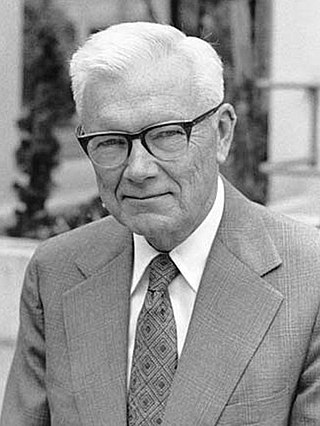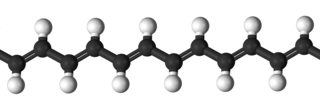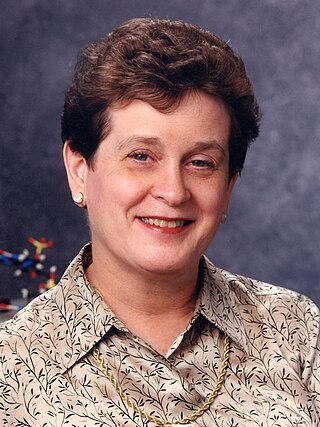Related Research Articles
Polymer chemistry is a sub-discipline of chemistry that focuses on the structures of chemicals, chemical synthesis, and chemical and physical properties of polymers and macromolecules. The principles and methods used within polymer chemistry are also applicable through a wide range of other chemistry sub-disciplines like organic chemistry, analytical chemistry, and physical chemistry. Many materials have polymeric structures, from fully inorganic metals and ceramics to DNA and other biological molecules. However, polymer chemistry is typically related to synthetic and organic compositions. Synthetic polymers are ubiquitous in commercial materials and products in everyday use, such as plastics, and rubbers, and are major components of composite materials. Polymer chemistry can also be included in the broader fields of polymer science or even nanotechnology, both of which can be described as encompassing polymer physics and polymer engineering.

Paul John Flory was an American chemist and Nobel laureate who was known for his work in the field of polymers, or macromolecules. He was a leading pioneer in understanding the behavior of polymers in solution, and won the Nobel Prize in Chemistry in 1974 "for his fundamental achievements, both theoretical and experimental, in the physical chemistry of macromolecules".

Polymer science or macromolecular science is a subfield of materials science concerned with polymers, primarily synthetic polymers such as plastics and elastomers. The field of polymer science includes researchers in multiple disciplines including chemistry, physics, and engineering.

Eric Baer, is an American scientist and engineer known for his major research and educational contributions to polymer science and engineering. He is a leading pioneer in understanding the complex relationships between solid state structure, processing, and properties of polymeric materials and systems.

Manson Benedict was an American nuclear engineer and a professor of nuclear engineering at the Massachusetts Institute of Technology (MIT). From 1958 to 1968, he was the chairman of the advisory committee to the U.S. Atomic Energy Commission.

Herman Francis Mark was an Austrian-American chemist regarded for his contributions to the development of polymer science. Mark's x-ray diffraction work on the molecular structure of fibers provided important evidence for the macromolecular theory of polymer structure. Together with Houwink he formulated an equation, now called the Mark–Houwink or Mark–Houwink–Sakurada equation, describing the dependence of the intrinsic viscosity of a polymer on its relative molecular mass. He was a long-time faculty at Polytechnic Institute of Brooklyn. In 1946, he established the Journal of Polymer Science.
Fred Basolo was an American inorganic chemist. He received his Ph.D. at the University of Illinois at Urbana-Champaign in 1943, under Prof. John C. Bailar, Jr. Basolo spent his professional career at Northwestern University. He was a prolific contributor to the fields of coordination chemistry, organometallic, and bioinorganic chemistry, publishing over 400 papers. He supervised many Ph.D. students. With colleague Ralph Pearson, he co-authored the influential monograph "Mechanisms of Inorganic Reactions", which illuminated the importance of mechanisms involving coordination compounds. This work, which integrated concepts from ligand field theory and physical organic chemistry, signaled a shift from a highly descriptive nature of coordination chemistry to a more quantitative science.
Carl Shipp "Speed" Marvel was an American chemist who specialized in polymer chemistry. He made important contributions to U.S. synthetic rubber program during World War II, and later worked at developing polybenzimidazoles, temperature-resistant polymers that are used in the aerospace industry, in fire-fighting equipment, and as a replacement for asbestos. He has been described as "one of the world's outstanding organic chemists" and received numerous awards, including the 1956 Priestley Medal and the 1986 National Medal of Science, presented by President Ronald Reagan.

Krzysztof "Kris" Matyjaszewski is a Polish-American chemist. He is the J.C. Warner Professor of the Natural Sciences at the Carnegie Mellon University Matyjaszewski is best known for the discovery of atom transfer radical polymerization (ATRP), a novel method of polymer synthesis that has revolutionized the way macromolecules are made.

Wilma K. Olson is the Mary I. Bunting professor at the Rutgers Center for Quantitative Biology (CQB) at Rutgers University. Olson has her own research group on the New Brunswick campus. Although she is a polymer chemist by training, her research aims to understand the influence of chemical architecture on the conformation, properties, and interactions of nucleic acids.
Dr. Joseph B. Schlenoff is a distinguished research professor and Leo Mandelkern Professor of Polymer Science of the Department of Chemistry and Biochemistry at Florida State University. He graduated with his Doctorate in Chemistry from UMass-Amherst in 1987 and became a professor at Florida State University in 1988. A leading scientist in the field of water-soluble polymers and biocompatible polymer composites and blends, Dr. Schlenoff has discovered a process for creating biomaterials that can be used in surgical implants designed for the extended release of certain medications and holds 30 issued and many pending patents. This number of issued patents places him second among faculty at Florida State University behind only Robert A. Holton. He is the founder of the start-up, nanoStrata, a company that manufactures novel robots to create biofilms. Dr. Schlenoff was one of three researchers from around the world awarded a Gutenberg Chair for 2011 at the Université de Strasbourg in France. In 2013, Dr. Schlenoff was awarded the Florida Award from the American Chemical Society.

Eugene George Rochow was an American inorganic chemist. Rochow worked on organosilicon chemistry; in the 1940s, he described the direct process, also known as the Rochow process or Müller-Rochow process.

The Charles Goodyear Medal is the highest honor conferred by the American Chemical Society, Rubber Division. Established in 1941, the award is named after Charles Goodyear, the discoverer of vulcanization, and consists of a gold medal, a framed certificate and prize money. The medal honors individuals for "outstanding invention, innovation, or development which has resulted in a significant change or contribution to the nature of the rubber industry". Awardees give a lecture at an ACS Rubber Division meeting, and publish a review of their work in the society's scientific journal Rubber Chemistry and Technology.
The Melvin Mooney Distinguished Technology Award is a professional award conferred by the American Chemical Society, Rubber Division. Established in 1983, the award is named after Melvin Mooney, developer of the Mooney viscometer and of the Mooney-Rivlin hyperelastic law. The award consists of an engraved plaque and prize money. The medal honors individuals "who have exhibited exceptional technical competency by making significant and repeated contributions to rubber science and technology".
James E. Mark was a Distinguished Research Professor at the University of Cincinnati.
Russell A. Livigni is a rubber industry scientist and executive noted for his discovery and development of high trans styrene-butadiene rubber, a crystallizing rubber that provides superior oxidation resistance relative to natural rubber.
Joseph A. Kuczkowski is a Goodyear scientist, noted for successfully explaining the mechanisms of antioxidant and antiozonant function, and for commercial development of new antiozonant systems and improvement of the stability of polymeric materials.

John Drake Hoffman was an American chemist and author who was awarded the Soldier's Medal, the United States Army's highest award for an act of valor in a non-combat situation, and the only one awarded to a member of the Manhattan District. After the war he worked for the National Bureau of Standards, becoming the director of its national measurements laboratory. He was a professor and director of the engineering materials program at the University of Maryland from 1982 to 1985, director of the Michigan Molecular Institute, and a professor of materials science and engineering at Johns Hopkins University.

Sylvia Marie Stoesser, was an American chemist. She was the first woman to be employed as a chemist at Dow Chemical Company. During her time at Dow, she made a number of major contributions, holding more than two dozen patents as a result of her research.
Rufina G. Álamo Matesanz is a Spanish-American polymer scientist known particularly for her research on polyethylene and polypropylene and on sustainable polymers such as polyoxymethylene made from biomass. She is Simon Ostrach Professor of Engineering and Distinguished Research Professor of Chemical and Biomedical Engineering in the Florida A&M University – Florida State University College of Engineering.
References
- ↑ Center for Oral History. "Leo Mandelkern". Science History Institute .
- ↑ Bohning, James J. (28 April 1986). Leo Mandelkern, Transcript of an Interview Conducted by James J. Bohning at Florida State University on 28 April 1986 (PDF). Philadelphia, PA: The Beckman Center for the History of Chemistry.
- ↑ Mandelkern, Leo (1993). "Role of elastomers in the study of polymer crystallization". Rubber Chemistry and Technology. 66 (3): G61–G75. doi:10.5254/0035-9475-66.3.g61.
- ↑ Mark, James E.; Mattice, Wayne L. (1987). "Leo Mandelkern, One of the Pioneers of Polymer Science". Macromolecules. 20 (2): 235–236. Bibcode:1987MaMol..20..235M. doi:10.1021/ma00168a600.
- ↑ "Leo Mandelkern" . Retrieved 7 Dec 2013.